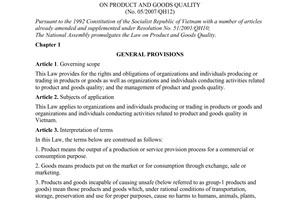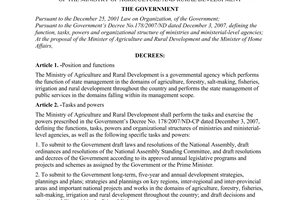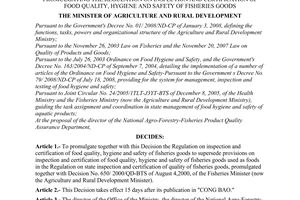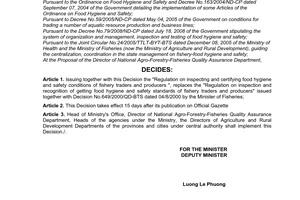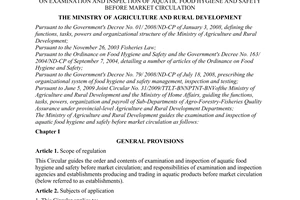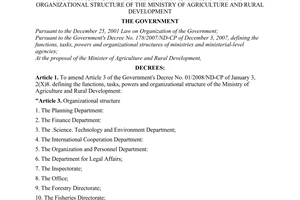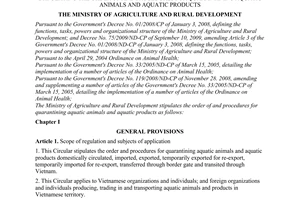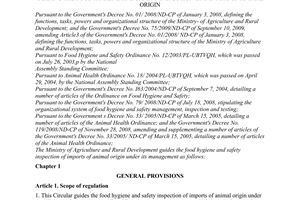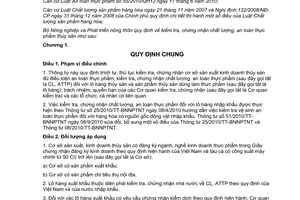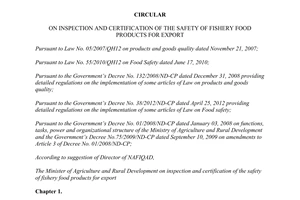Circular No. 55/2011/TT-BNNPTNT on inspecting and certifying aquacultural đã được thay thế bởi Circular 48/2013/TT-BNNPTNT inspection certification safety fishery food products export và được áp dụng kể từ ngày 26/12/2013.
Nội dung toàn văn Circular No. 55/2011/TT-BNNPTNT on inspecting and certifying aquacultural
|
THE
MINISTRY OF AGRICULTURE AND RURAL DEVELOPMENT |
THE
SOCIALIST REPUBLIC OF VIETNAM |
|
Hanoi, August 03, 2011 |
CIRCULAR
ON INSPECTING AND CERTIFYING AQUACULTURAL PRODUCT QUALITY AND SAFETY
THE MINISTER OF AGRICULTURE AND RURAL DEVELOPMENT
Pursuant to the Government's Decree No. 01/2008/ND-CP of January 03, 2008 defining the functions, tasks, powers and organizational structure of the Ministry of Agriculture and Rural development; the Government's Decree No. 75/2009/ND-CP on amending Article 3 of the Decree No. 01/2008/ND-CP;
Pursuant to the Law on Food safety No. 55/2010/QH12 of June 17, 2010;
Pursuant to the Law on Product and goods quality of November 21, 2007 and the Government's Decree No. 132/2008/ND-CP of December 31, 2008 detailing the implementation of a number of articles of the Law on Product and goods quality;
The Ministry of Agriculture and Rural development prescribes the inspection and certification of aquacultural product quality and safety as follows:
Chapter I
GENERAL PROVISIONS
Article 1. Scope of regulation
1. This Circular prescribes the order, procedures for inspecting and certifying the qualification of food safety for facilities producing and trading aquacultural products; inspecting and certifying food safety and quality regarding aquacultural consignments and aquacultural products being used as food (hereinafter referred to as consignments); responsibilities and authority of inspection and certification agencies (hereinafter referred to as inspection agencies) and relevant organizations and individuals.
2. The inspection and certification of food safety and quality regarding imported consignments are implemented under the Circular No. 25/2010/TT-BNNPTNT of April 08, 2010 guiding the inspection of food hygiene and safety regarding imported goods of animal origin, Circular No. 51/2010/TT-BNNPTNT of September 08, 2010 on amending and supplementing a number of articles of the Circular No. 25/2010/TT-BNNPTNT and the Circular No. 06/2010/TT-BNNPTNT.
Article 2. Subjects of application
1. Facilities producing and trading aquacultural products that have registered to conduct food business in the Certificate of business registration as prescribed by current Vietnam’s law provisions and have fishing ships with the primary engine power from 50 CV and above (hereinafter referred to as Facilities):
a) Facilities with products for export;
b) Facilities with products for domestic consumption only;
2. Exported consignments subject to state inspection and certification of food safety and quality as prescribed by Vietnam’s and importing countries’ law provisions.
3. For exported consignments with request for quarantine certification as prescribed by current law provisions, inspection agencies prescribed in clause 1 Article 5 of this Circular shall concurrently carry out the quarantine and the food safety and quality inspection.
Article 3. Interpretation of terms
In this Circular, the following terms are construed as follows:
1. Fishing ports: mean ports specialized for fishing ships, including port land and anchorage water. Port land includes wharves, depots, workshops, administrative zone, services of logistics, trading, export and import of aquacultural products. .
2. Facilities producing aquacultural products: mean facilities with fixed location conducting one, a number of or all kinds of activities including producing, processing, preliminary processing, packaging, preserving in order to create aquacultural food.
3. Facilities trading aquacultural products: mean facilities performing one, a number of or all kinds of services including preserving, transporting or trading aquacultural food.
4. Markets with aquacultural product trading: mean fixed locations where the trading of aquacultural products take place, it might include procurement and preliminary processing.
5. Independent facilities producing aquacultural products: mean facilities with sufficient facilities and equipment to completely carry out a separate production process from receiving to preserving finished products in a locations; having the separate workforce of quality control officers with at least 3 employees that carry out food safety and quality inspection during the production, and at least 01 (one) employee that has been issued by competent agencies with the Certificate on finishing the relevant training course in quality control under the HACCP approach.
6. Independent cold storage for aquacultural product preservation: mean heat-insulated buildings with one or multiple artificially refrigerated rooms in order to provide frozen aquacultural product preservation services.
7. Origin tracing: means the ability to monitor and identify a product unit by each stage of the production, processing and distribution.
8. Sampling: means the intentional selection of samples and transfer to appointed test labs to analyze the food safety and quality norms..
9. Produced consignments: mean a volume of products being produced from one or multiple material lots with sufficient information about the origin in the same technological process and production conditions within 24 hours in one facility.
10. Exported consignments: means the volume of goods applied for inspection by goods owners for single export to one importer on one means of transport.
11. Initial sample: means the volume of products or one package unit taken from one position in the produced consignment.
12. Joint sample means the sample combined from initial samples
13. Average sample: means the volume of products or a number of package units taken from the joint sample.
14. Test sample: means the sample taken from the average sample to analyze the food safety and quality norms.
15. Retained sample: means the sample taken from the average sample and preserved in the condition that does not change its original property and used for comparing test when necessary.
16. Aquacultural food means all the aquatic and amphibious animals or plants, including eggs and their organs, being used as food or blending food of which the ingredient contains aquacultural products,
17. Group of similar aquacultural food means the aquacultural products with the same risk of food safety, being produced from similar technological processes in one facility.
18. Instant aquacultural food means aquacultural products that can be directly used by human without any special process before eating.
Article 4. Bases for inspection and certification
1. Bases for inspection and certification are Vietnam’s provisions, technical regulation on necessary conditions for food safety in aquacultural production and trading; the quality and safety of aquacultural food.
2. Facilities with exported aquacultural products, apart from satisfying the contents prescribed in clause 1 this Article, must satisfy the requirements under international treaties that Vietnam has signed or joined and the importing countries’ provisions.
Article 5. Inspection agencies
1. The Central inspection agency being the Department of Agro-forestry and aquacultural product quality control and affiliated units shall be responsible to:
a) Inspect and certify the qualification of food safety for the facilities prescribed in point a clause 1 Article 2 of this Circular, including facilities with aquacultural products for both domestic consumption and export;
b) Inspect and certify the qualification of food safety and quality for aquacultural consignments and aquacultural products used for food prescribed in clause 2, clause 3 Article 2 of this Circular.
2. Local inspection agencies:
a) Provincial level: are Sub-departments of Agro-forestry and aquacultural product quality control (or professional agencies appointed by the Service of Agriculture and Rural development in central-affiliated cities and provinces regarding provinces and cities without any Sub-department of Agro-forestry and aquacultural product quality control) and responsible to inspect and certify the qualification of food safety for the facilities prescribed in point b clause 1 Article 2 of this Circular consistently with the decentralization of the Ministry of Agriculture and Rural development prescribed in the Circular No. 14/2011/TT-BNNPTNT of March 29, 2011 (hereinafter referred to as Circular 14);
b) District level: are Professional agencies belonging to district-level People’s Committees, responsible to inspect and certify the qualification of food safety for producing facilities prescribed in point b, clause 1 Article 2 of this Circular (except for fishing boats) being issued with the Certificate of business registration by the district level;
c) Commune level: are commune-level People’s Committees, responsible to inspect and certify the qualification of food safety for local producing facilities prescribed in point b, clause 1 Article 2 of this Circular being issued with the Certificate of business registration by the commune level;
d) In case the commune-level, district-level agencies are not capable of performing the duties prescribed in point b, point c clause 2 this Article, basing on actual conditions, provincial-level inspection agencies appointed by the Services of Agriculture and Rural development shall be responsible to perform the corresponding duties allocated to such commune-level, district-level agencies and shall hand over the duties right after the commune-level, district-level agencies are capable.
Article 6. Requirements for inspectors and the chief inspector
1. For inspectors:
a) Honest, objective, not directly or indirectly relating to economic interests with the inspected goods owners or the producing facility owners;
b) Having appropriate profession and possessing the certificate of finishing the training course in aquacultural food safety and quality inspection and certification;
c) Physically capable of the assigned duties;
d) Having specialized clothing and badges as prescribed when performing the duties;
2. For the Chief inspector: experienced in inspection apart from the requirements prescribed in clause 1 this Article.
Article 7. Requirements for equipment and tools serving the field inspection
1. Specialized, clearly distinguishable from other tools.
2. In good operating and preserving conditions, being tested and calibrated as prescribed; in good hygiene conditions, not being the source of infection
Article 8. Requirements for test labs
Test labs participating in analysis, examination and test on food safety and quality norms serving the inspection, assessment and classification of conditions for food safety assurance of the facilities; conducting state inspection and certification of food safety and quality for the consignments must be appointed by competent agencies as prescribed by Ministry of Agriculture and Rural development.
Chapter II
INSPECTING AND CERTIFYING THE QUALIFICATION OF FOOD SAFETY FOR FACILITIES
SECTION 1. ORDER, PROCEDURES, CONTENTS AND HANDLING OF THE INSPECTION AND CERTIFICATION RESULTS
Article 9. Dossier on applying for inspection and certification
1. Facilities being issued with the Certificate of Facility qualified of food safety conditions (hereinafter referred to as Food safety certificate) for aquacultural product production and trading shall make 01 (one) application for inspection and send to inspection agencies under decentralization prescribed in Article 5 this Circular to be inspected and issued with the Food safety certificate.
2. The application for inspection includes:
a) The inspection registration sheet under the form in Annex 1 promulgated together with this Circular;
b) The authenticated copy of the Certificate of business registration of the facility (not applicable to fishing ships);
c) The status report on the conditions for food safety of the facility under the form in Annex 2 promulgated together with this Circular (not applicable to fishing ships);
d) The summary of HACCP plan for similar groups of products applying for inspection (applicable to facilities compelled to build and implement the Food safety and quality assurance program under the HACCP approach as prescribed in the National technical Regulation QCVN 02 – 02: 2009/BNNPTNT);
3. For facilities applying for inspection after having rectified the faults in the previous inspection, the dossier only consists of 01 (one) report of fault rectification under the form in Annex 3 promulgated together with this Circular and send to the inspection agencies.
4. The application for inspection shall be sent to inspection agencies in one of the forms such as: direct submission, by post; or fax, email, online registration (the facilities shall then send 01 Inspection application sheet or Report on fault rectification to inspection agencies, the remaining dossiers shall be presented to the inspectorate during the inspection).
Article 10. Notifying the inspection plan
1. Inspection agencies shall cooperate with the agencies issuing Certificates of business registration and the agencies issuing Certificates of fishing boat registration to make statistics and lists of facilities under the allocated management scope and decentralization prescribed in clause 1 Article 2 of this Circular, and notify the facilities of the inspection plan in one of the forms such as direct sending, via fax or email.
2. For facilities applying for inspection:
a) Within 03 (three) working days as from receiving the application for inspection from the facilities, the inspection agencies shall consider and guide the facilities to supplement the omitted or improper contents;
b) In case the dossier is valid, within 05 (five) working days, inspection agencies must notify the facilities of the scheduled inspection time. Such time must not be later than 15 (fifteen) working days as from fully receiving the dossier.
3. In case the facility omits to apply for inspection, the agencies still carry out inspection under the plan.
4.For fishing ships, inspection agencies shall uniformly make agreements with the ship owners to determine the appropriate time and place for the practical operation of the ship.
Article 11. Forms of inspection
1. Assessing, classifying inspection: means ways of inspection with advance notice that fully inspect the norms of necessary conditions for food safety of the facility. This form of inspection is applicable to:
a) Facilities qualified for the Food safety certificate in aquacultural production and business but not yet being issued with it;
b) Facilities that have the Food safety certificates withdrawn;
c) Facilities with the Food safety certificate term less than 6 (six) months;
d) Facilities that have been issued with the Food safety certificate but then replace the owner or undergo repairs, upgrades or expansion of the production that cause changes to the possibility of food safety risks;
dd) Facilities adding products not belonging to the certified similar group of products;
e) Facilities that have been issued with the Food safety certificate as prescribed in point a clause 1 Article 16 of this Circular but then make production and business transformation from domestic consumption to export;
g) Facilities applying for additional registration in the list of facilities entitled to export to importing countries that request to make the list;
h) Facilities certified as food safety qualified but have been delaying the periodic inspection for over 12 (twelve) months.
2. Periodic inspection: is the form of inspection without notice in order to sustain the necessary food safety conditions for facilities that have been issued with the Food safety certificate.
3. Irregular inspection: is the form inspection without notice applicable to facilities with signs of violations of food safety and quality, or being lodge complaints against by organizations and individuals.
Article 12. Establishing the Inspectorate
1. The Heads of inspection agencies shall issue decisions on establishing Inspectorates of food safety conditions.
2. The decision on establishing the Inspectorate consists of the following contents:
a) Basis for inspection;
b) Scope, contents, form and scheduled inspection time;
c) Name, address and code (if any) of the inspected facility;
d) Full name, positions and the unit of the Chief inspector and the members;
dd) Responsibilities of the inspected facility and the Inspectorate.
3. The decision on establishing the Inspectorate must be notified at the facility when the inspection begins.
Article 13. Contents and methods of inspection
1. The contents of food safety condition inspection includes:
a) Aquacultural food safety conditions for facilities, equipment and persons directly participating in the production and business.
b) Quality control program;
c) Procedures for tracing product origins;
d) Sampling in order to examine the efficiency of food safety control of the facility if necessary (not applicable to the cases when inspection agencies being commune-level People’s Committees). In case of sampling, the Inspectorate must make the sampling sheet that contains the signature of the Chief inspector and the competent representative of the facility.
2. The methods of inspection and guidance of assessment shall be implemented under the Annex promulgated together with the Circular 14 and Annex 4 promulgated together with this Circular.
Article 14. Inspection record
1. The inspection record must:
a) Fully and accurately present the inspection results under the prescribed form and must be made at the facility right after the inspection is done;
b) Fully specify the unqualified contents of food safety and the time limits for rectification;
c) Specify the general conclusion on the food safety conditions and the rating of the facility as prescribed in Article 15 of this Circular;
d) Contain the opinion of the competent representative from the facility on the inspection results and the commitment to rectify the faults;
dd) Contain the signatures of the Chief inspector, the competent representative from the facility. The inspection record must be sealed or signed on every page in case the facility has no seal.
e) Be made into 2 (two) copies: 1 (one) copy to be retained in the inspection agency, 1 (one) copy to be retained in the facility. The number of copies might be increased if necessary.
2. In case the facility representative refuses to sign on the Inspection record or to form the opinion on the inspection results or to commit to rectify the faults, the Inspectorate must put down: “The facility representative refuses to sign the record” and specify the reason for that. Such record is still as much legally valid upon fully having the signatures of the Inspectorate members.
Article 15. Rating the food safety conditions of facilities
The ratings of food safety conditions are applied to facilities as follows:
1. Rated A (good): applicable to facilities that fully satisfy the necessary conditions for food safety without major or serious faults;
2. Rated B (passed): applicable to facilities that satisfy the necessary conditions for food safety with inconsiderable amount of major or serious faults;
3. Rated C (failed): applicable to facilities that fail to satisfy the necessary conditions for food safety with considerable amount of major or serious faults that will seriously affect the food quality safety if they continue to produce without rectifying the faults within the time limit prescribed by inspection agencies.
4. The ratings of each facility form are prescribed in the Annex promulgated together with the Circular 14 and Annex 4 promulgated together with this Circular.
Article 16. Handling the inspection results
Within 07 (seven) working days as from the ending day of the inspection, inspection agencies shall examine the inspection record of the Inspectorate, handle the results and send the inspection results to the facilities directly or via post services. In particular:
1. Inspecting and rating:
a) Passed facilities (rated A or B): issue the Decision on certifying food safety qualification, issue the Food safety certificate with the term of 3 (three) years as from the date of issue under the Annex 5 promulgated together with this Circular, and 01 (one) code for the facility under the code system in Annex 6 promulgated together with this Circular when the facility owner applies for the Food safety certificate.
b) Failed facilities (rated C): Notify the inspection results and request the facilities to make reports on specific rectification results. Depending on the fault extent, inspection agencies shall determine the time limit for rectification and carry out the inspection again. If the facility continues to fail the food safety (rated C), inspection agencies shall revoke the Food safety certificate (if the facility has been issued with) and notify the competent agencies to impose administrative sanctions, notify the functional agencies to consider the revocation of the Certificate of business registration that has been issued to the facility.
2. Periodic and irregular inspections:
a) For passed facilities (rated A or B): Notify the facility of the inspection results and inspection rates being applied in the future;
b) For rated C facilities: implement the provisions prescribed in point b clause 1 this Article.
3. In case of sampling, if violations of food safety or risk of food insecurity are detected, inspection agencies shall request the facility to make report on rectification results including tracing and recalling products as prescribed by current law provision, and shall carry out irregular inspection of the rectification if necessary.
Article 17. Updating the list of facilities entitled to export to markets in demand
1. Facilities shall be added into the list of facilities entitled to export to markets that request to make the list if the following conditions are satisfied:
a) Having registered with inspection agencies under the procedures prescribed in Article 9 of this Circular;
b) Having built and applied the quality control programs consistently with the requirements of the importing countries and fully retained the files at least 30 days of production by the inspection day;
c) Having been inspected and certified the fulfillment of the requirements from the corresponding importing countries.
2. Facilities shall be removed from the list of facilities entitled to export to markets that request to make the list when such facilities send to inspection agencies the written request for removal of name from the list of export market, or when such facilities violate the provisions in clause 1 Article 19 of this Circular.
3. The time the Department of Agro-forestry and aquacultural product quality control update the list of facilities entitled to export shall comply with the provisions of each importing country or the procedures agreed with the importing countries’ competent agencies.
SECTION 2. SUPERVISING THE NECESSARY CONDITIONS FOR FOOD SAFETY OF THE FACILITIES AND REVOKING THE FOOD SAFETY CERTIFICATE
Article 18. Rate of periodic inspection
1. Inspection frequency:
a) Rated A facilities: once a year;
b) Rated B facilities: every 6 months;
c) Rated C: the time of irregular inspection depends on the fault extent of the inspected facilities and determined by inspection agencies within 03 (three) months as from the date of previous inspection.
2. For passed fishing ships (rated A or B), local inspection agencies shall carry out inspection for anchored ships in the port at least 2 (twice) every 3 (three) years and ensure the minimum period between the inspections being 1 (one) year.
Article 19. Revocation of Food safety certificate
1. Facilities shall have the Food safety certificates revoked in the following cases:
a) Facilities that have issued with the Food safety certificate but the food safety condition inspection results are rated C after 02 (two) consecutive inspections;
b) Facilities requesting the delay of inspection but being detected continuing to produce and sell products on the market during the inspection delay;
c) Facilities producing and trading that cause obstructions when the Inspectorate performing their duties as prescribed in this Circular;
d) Facilities violating the provisions on impurity control;
dd) Facilities violating the provisions on the use of banned chemicals or antibiotics;
e) Facilities violating the provisions on labeling the aquacultural consignments;
g) Facilities procuring or using material from aquacultural product raising facilities, aquacultural product raising areas and bivalve mollusk reaping areas that are banned or suspended from reaping by competent agencies because of the unreliability of food safety;
h) Facilities forging, changing the contents of Food safety certificates; forging, changing the contents of food safety and quality certificates of aquacultural consignments, or the Certificate of analysis, examination results serving the state inspection and certification of inspection agencies;
i) Facilities committing other violations shall be considered and determined by the Minister of Agriculture and Rural development.
2. Inspection agencies shall make and send the written revocation of Food safety certificate to the facilities, remove the names of such facilities from the list of facilities entitled to export to importing countries that requested to make the list (applicable to the facilities prescribed in point a clause 1 Article 2 of this Circular), concurrently make and send the dossier on handling request to competent agencies as prescribed by law provisions on food safety.
Article 20. Re-issue of Food safety certificates
1. Food safety certificates shall be re-issued in the following cases: the Certificate is lost or damaged; the facility has changed or added relevant information in the Certificate (except for the facilities prescribed in clause 1 Article 11 of this Circular); fishing ships that have been certified but then replace the owner or change the area;
2. The re-issue of Food safety certificate shall be implemented as follows:
a) Facilities shall send to inspection agencies the written request specifying the reasons for re-issuing the Food safety certificate under the Annex 7 promulgated together with this Circular.
b) The amount of dossier: 01 written request for re-issuing the Food safety certificate;
c) Facilities may submit directly, or via fax, email, website (then send the original copies); by post;
d) Within 03 (three) working days as from receiving the written request for re-issuing the Food safety certificate from the facilities, inspection agencies shall issue the Food safety certificates to the facilities
3. The expiry date of the Food safety certificate being re-issued shall be the same as that of the old Food safety certificate.
Chapter III
INSPECTING AND CERTIFYING THE FOOD SAFETY AND QUALITY FOR AQUACULTURAL CONSIGNMENTS
SECTION 1. REQUIREMENTS FOR THE CONSIGNMENTS BEING SOLD IN THE MARKET
Article 21. Conditions for consignments being sold in the domestic market
Implemented under the Circular No. 56/2009/TT-BNNPTNT of September 07, 2009 promulgated by the Ministry of Agriculture and Rural development, guiding the inspection and supervision of aquacultural food safety and hygiene before being sold in the market and the Circular No. 23/2011/TT-BNNPTNT of April 06, 2011 on amending, supplementing and abolishing a number of provisions on administrative procedures in aquacultural product quality control under the Resolution No. 57/NQ-CP.
Article 22. Conditions for consignments to be eligible for export
1. Being produced from facilities that have been certified the food safety condition qualification as prescribed in this Circular and satisfying the provisions on food safety assurance of corresponding importing countries.
2. Being inspected and issued with the food safety and quality certificates under the provisions of importing countries and the Ministry of Agriculture and Rural development.
3. The labels on exported aquacultural consignments may contain the information required by the importer but must not falsify the goods property and violate Vietnam’s and the importing countries’ law. Apart form the compulsory information under the importing countries’ provisions, the exported consignment must also contain the following information:
a) The producing facility code
c) The consignment code.
4. Consignments being produced from different producing facilities must satisfy the following conditions to be eligible for export:
a) The facility that performs the final stage of production (packaging and labeling) and the facilities performing the previous stages must satisfy the food safety conditions as prescribed by Vietnam’s law provisions and the provisions of the market where the finished products are consumed;
b) Facilities participating in the consignment production must make written commitment to bear responsibilities for implementing the handling measures from inspection agencies in case the consignment in warned by importing countries’ competent agencies or detected with violations of food safety and quality by inspection agencies.
c) Facilities participating in the consignment production are responsible to fully retain the files of production and food safety and quality control for the stage of production that they performed, ensuring the feasibility of product origin tracing;
d) The goods owners must report to inspection agencies when implementing the procedures for inspecting and certifying food safety and quality of the exported consignment; report to the Inspectorate when being inspected at the facilities where the production stages of the consignment are performed.
SECTION 2. ORDER, PROCEDURES, CONTENTS OF INSPECTION AND CERTIFICATION FOR EXPORTED CONSIGNMENTS
Article 23. Registering the food safety and quality inspection and certification
1. The application for inspection of 01 (one) exported consignment includes:
a) The inspection registration sheet under the Annex 8 promulgated together with this Circular;
b) The detailed statement of the consignment under the Annex 8a promulgated together with this Circular;
2. The goods owner shall send 01 dossier on inspection application to the inspection agency directly or via post office, fax, emails, online registration (then the facility shall send 01 Inspection registration sheet to the inspection agency).
3) Handling the applications:
Within 01 (one) working day as from receiving the application as prescribed in clause 1 this Article, inspection agencies shall consider and guide goods owners to supplement the omitted or improper contents;
b) For consignments being inspected and sampled, the inspection time must not be later than 02 (two) working days after inspection agencies fully receive the applications or after the agreement between inspection agencies and goods owners are made under the goods owners’ application.
Article 24. Forms of inspection
1. Dossier inspection: is the form of inspection that only inspects the applications of goods owners, compares the relevant information about the food safety conditions of the facilities that produced the consignments, and considers, issues the food safety and quality certificates without field inspections.
2. Inspecting and sampling: is the form of inspection that inspects the applications of goods owners and carries out inspection and sampling of the consignment in the field.
Article 25. Methods of inspection and sampling
1. Reduced inspection: applicable to facilities concurrently satisfy the following requirements within 12 (twelve) months before the time of reduced inspection
a) The conditions for food safety are rated A;
b) No consignment is detected by inspection agencies or warned by importing countries’ competent agencies about the violations of food safety and quality;
c) No violations of food safety and quality are detected by competent agencies during the inspection.
2. Regular inspection: is the mode of inspection applicable to facilities qualified of food safety (rated A or B).
3. Tight inspection: is the mode of inspection applicable to facilities belonging to one of the following cases:
a) The food safety conditions of the facilities are rated C but the Food safety certificate has not been revoked;
b) Having consignments warned about food safety and quality by importing countries’ competent agencies.
4. Inspection frequency:
a) The frequency of inspecting and sampling consignments from facilities prescribed in clause 1, clause 2 and point a clause 3 this Article shall complies with the provisions in Annex 9 promulgated together with this Circular;
b) For facilities subject to the inspection methods prescribed in point 3 clause 3 this Article, inspection agencies shall carry out inspection and sampling of the produced consignments or exported consignments of the similar group of products from the facilities in order to analyze the warned norms under the market provisions. The facilities shall be released from tight inspection if 5 (five) consecutive consignments pass the inspection and pass the remedial measure appraisal from inspection agencies;
c) Facilities shall have the reduced inspection cancelled if they fail to satisfy one of the conditions prescribed in clause 1 this Article.
5. Procedures for consignment inspection and sampling are implemented as prescribed in Annex 10 promulgated together with this Circular.
Article 26. Issuing the Food safety and quality certificate
1. For consignments from facilities subject to the inspection mode prescribed in clause 1 Article 24 of this Circular that have passed the inspection: Inspection agencies shall issue the Food safety and quality certificate (hereinafter referred to as Certificate) under the Annex 11 promulgated together with this Circular to goods owners within 01 (one) working day as from fully receiving the dossier and information serving the certification.
2. For consignments from facilities subject to the inspection mode prescribed in clause 2 Article 24 of this Circular: after the field inspection is done, inspection agencies shall issue the Certificate to consignments with positive inspection results within the following time limits:
a) Within 01 (one) working day for fresh/raw consignments;
b) Within 07 (seven) working days for consignments of other kinds;
c) In case the samples must be sent to external test labs, inspection agencies shall issue the Certificate to goods owners within 1 (one) working day as from fully receiving the examination results.
3. For consignments being exported to importing countries that require separate certificate form:
a) Goods owners are responsible to sufficiently provide information in writing for inspection agencies to issue the separate certificate within 01 (one) working day after the consignment is exported;
b) Within 1 (one) working day as from fully receiving the information, inspection agencies shall issue the separate Certificate to the exported consignment.
4. In case the goods owner requests to be transitionally issued with the Certificate or separate certificate for the consignment, the inspection agency shall inspect the consignment and the inspection agencies issuing the transitional Certificate or separate certificate shall be responsible to make the transitional issue satisfy the following requirements:
a) Being made within the date of receiving the initial Certificate or separate certificate;
b) The contents of transitional certificates or separate certificates must be consistent with the initial certificates and separate certificates.
5. Within 60 (sixty) days after the consignment is inspected, if the goods owner fails to fully provide information for inspection agencies to issue the certificate or separate certificate, such goods owner must apply for another inspection of the consignment as prescribed in Article 23 of this Circular in order to be certified.
Article 27. Requirements for Certificates and separate certificates
1. For each exported consignment with positive inspection results, inspection agencies shall issue 01 (one) Certificate or separate certificate. The certificates or separate certificate is only applicable to the consignment being transported, preserved in a way that does not change the inspected and certified contents of food safety and quality.
2. The Certificates and separate certificates are numbered as prescribed in Annex 12 promulgated together with this Circular.
3. The separate certificate must contain appropriate contents, forms and the national Emblem.
4. Inspection agencies are entitled to issue other kinds of certificates (without the national Emblem) at the request of goods owners or importing countries consistently with the inspected and certified contents of the consignments.
Article 28. Supervising the consignment after certification
1. Quarterly or irregularly on demand, inspection agencies shall establish inspectorates to cooperate with the Customs to inspect the consignments at the gathering places when the consignments are queuing for the customs procedures for export in order to inspect the information of the consignments after certifying.
2. If the violations are detected, inspection agencies shall examine records from the inspectorates in order to issue the written revocation of the Certificate or separate certificate (issued) and send to goods owners, and request the Customs to refuse the custom clearance for the consignments. Depending on the violation extent, inspection agencies shall send written request to competent agencies for imposing administrative sanctions as prescribed by current law provisions.
Article 29. Re-issuing Certificates or separate certificates
1. When the Certificates, separate certificates are lost or damaged, goods owners must send written explanations and requests for the re-issue of Certificates or separate certificates to inspection agencies.
2. Inspection agencies shall re-issue within 1 (one) working day after receiving the written request from goods owners and must ensure that:
a) The contents of the Certificate or separate certificate being re-issued are consistent with the issued certificate;
b) The Certificates or separate certificates are re-numbered for management and contain the note: “This Certificate (separate certificate) supersedes the Certificate (separate certificate) No. …, Date of issue … “;
Article 30. Handling the failed consignments
1. For consignments failed in production dossiers, objective/subjective norms:
After 1 (one) working day after the inspection is done, inspection agencies shall send the Notice of failed consignment under the form prescribed in Annex 12 promulgated together with this Circular to goods owners.
2. For consignments failed in achieving the food safety and quality norms after having the examination results:
a) Inspection agencies shall send the Notice of failed consignment to goods owners, specify the reasons and request goods owners to investigate the causes, take remedial measures and make explanation reports;
b) After receiving the explanation report from the goods owner/facility that produced the consignment, inspection agencies shall verify the report content while inspecting and sampling the succeeding exported consignments of the goods owner, or combine the verification with the periodic inspection of food safety conditions for facilities that produced the failed consignment.
3. Within 3 (three) working days as from sending the Notice of failed consignment, if the goods owner send written complaints against the inspection results, inspection agencies shall handle under the order and procedures prescribed in Section 12.2 Annex 10 promulgated together with this Circular.
4. Inspection agencies shall carry out irregular inspection of food safety conditions in the following cases:
a) Facilities that have 6 or more the consignments of which the violations of food safety norms are detected by inspecting agencies within 3 (three) months under the provisions of Vietnam and the importing countries;
b) Facilities that fail to make explanation report at the request of inspection agencies in the Notice of failed consignment prescribed in point a clause 2 this Article.
Article 31. Handling consignments being warned about food safety and quality by importing countries’ competent agencies
1. Within 5 (five) working days as from having the official warning from importing countries’ competent agencies, inspection agencies shall send the facilities that produce the consignments the written request for:
a) Tracing the consignment origin, investigating the reasons for the unqualification of food safety and quality of the consignment; establishing and taking remedial actions; punctually making and sending reports to inspection agencies;
b) Temporarily suspending the export to corresponding countries if the importing countries’ competent agencies request, or if the facilities have more than 3 (three) consignments warned by importing countries’ competent agencies about food safety and quality within 6 (six) months.
2. After receiving the explanation reports from the facilities prescribed in clause 1 this Article and the tight inspection results prescribed in point b clause 3 Article 25 this Circular, inspection agencies shall verify the report contents of the facilities and carry out irregular inspection at the facilities (when necessary).
3. Within 10 (ten) days after the verification is done, inspection agencies shall send written notice of verification results to the facilities.
4. In case the goods owner/facility fails to fully report the contents or fails to make the report within the required time limit, inspection agencies shall send written request to the goods owner for taking remedial measures or report to competent agencies to handle as prescribed by law.
Chapter IV
RESPONSIBILITIES AND POWERS OF RELEVANT PARTIES
Article 32. Facilities being inspected of food safety conditions
1. Responsibilities:
a) Applying for the inspection under the order, procedures and dossiers prescribed in Article 9 this Circular. Observing the planned inspection from inspection agencies even when the inspection is not applied for;
b) Providing the list and arrangement of competent persons being representatives of the facility to work with the Inspectorate, facilitating the Inspectorate during their performance at the facility.
c) Fully providing information, dossier, relevant documents and samples at the request of the Inspectorate or independent inspectors, bearing responsibilities for the provided information and documents;
d) Sustaining the certified food safety conditions;
dd) Rectifying the faults stated in the inspection record and notices from inspection agencies within the required time limits;
e) Signing on the Inspection record.
2. Entitlements:
a) Forming dissenting or assenting opinion on the inspection results written in the inspection record;
b) Lodging complaint against the inspection results;
c) Promptly reporting to the heads of inspection agencies on the negative acts of the Inspectorate or Inspectors.
Article 33. Goods owners/owners of facilities that produced the consignments
1. Responsibilities:
a) Applying for food safety and quality inspection and certification of consignments with inspection agencies under the procedures and dossier prescribed in Article 23 this Circular;
b) Creating favorable conditions for inspectors of inspection agencies to carry out inspection, sampling; fully providing relevant documents and dossiers (for consignments subject to field inspection and sampling);
c) Retaining the product property and labels after being inspected and certified of food safety and quality;
d) Taking handling measures for consignments that failed the food safety and quality inspection, returned consignments or withdrawn consignments at the request of inspection agencies and competent agencies;
dd) Paying inspection and certification fees and charges as prescribed in Chapter V.
2. Entitlements:
a) Being applied the reduced inspection if the requirements prescribed in clause 1 Article 25 of this Circular are fully satisfied;
b) Requesting inspection agencies to provide the information, provisions and forms relating to the aquacultural food safety and quality inspection and certification as prescribed in this Circular;
c) Preserving the opinion contrary to the inspection results;
d) Requesting inspections;
dd) Lodging complaint and denouncing the improper acts of inspectors, inspection agencies and test labs as prescribed by law.
Article 34. Inspectors
1. When performing the allocated duties, inspectors are responsible to:
a) Observe the order, procedures, contents, methods and basis for inspecting food safety conditions of the facilities; inspect and sample the consignments as prescribed in this Circular;
b) Secure the information relating to the production and business of the facilities, goods owners as prescribed be law. Ensure the accuracy, fidelity and objectivity when performing duties;
c) Obey the allocation of competent persons and bear responsibilities for the work results before the Heads of inspection agencies and before the law;
2. Within the scope of the allocated duties, inspectors are entitled to:
a) Request facilities, goods owners to provide dossiers, documents, items (if any) serving the inspection;
b) Enter and leave the warehouses, production and preservation areas, examine the dossiers, take samples, pictures, make copies and records necessary information serving the inspection;
c) Make records and seal off the items (if any) in a certain period, request and suggest handling measures upon having evidence that the facility/goods owner is committing violations of provisions on food safety;
d) Preserve the opinion and send report to the Heads of inspection agencies in case such opinion is not consistent with the verdict of the person who directly allocate the duty prescribed in point c clause 11 this Article;
dd) Refuse to carry out inspection if the goods owner fails to fulfill the responsibilities prescribed in point c clause 1 Article 32 and point b clause 1 Article 33 of this Circular.
Article 35. The Chief inspector
1. When performing the assigned duties, the Chief inspector shall bear responsibilities similarly to that of an inspector prescribed in clause 1 Article 34 this Circular and the following responsibilities:
a) Operating, allocating tasks to members in the Inspectorate in order to fully implement the contents stated in the inspection decision;
b) Handling the opinions and inspection results from members in the Inspectorate and present the final results;
c) Reviewing, signing the inspection records, inspection result reports, bearing responsibilities before the Heads of inspection agencies and before law for the results given by the Inspectorate.
2. Within the scope of assigned duties, the Chief inspectors shall hold powers similarly to that of an Inspector prescribed in clause 2 Article 34 of this Circular and the following powers:
a) Suggesting the Heads of inspection agencies to issued decisions on replacing members of the Inspectorate in order to fully fulfill the contents stated in the inspection decision;
b) Drawing the final conclusion on the inspection results.
Article 36. Local inspection agencies
1. Responsibilities:
a) Making inspection plan as prescribed in clause 1 Article 10 of this Circular; organizing the inspection and issue of the Food safety certificate in aquacultural production and business under the allocation and decentralization prescribed in clause 2 Article 5 of this Circular;
b) Retaining dossiers relating to the inspection and issue of Food safety certificate to facilities belonging to the group of subjects allocated to be inspected and certified; providing dossiers, fully and accurately explaining the problems relating to the performed inspection and certification at the request of superior inspection agencies;
c) Securing the information relating to the production and business secret of the facilities allocated to be inspected and certified;
d) Summing up and sending reports in writing to superior inspection agencies every 06 (six) months or on request;
dd) Suggesting the demand for training or delegating officers to participate in training courses organized by superior inspection agencies;
2. Responsibilities of provincial-level inspection agencies:
Apart from the responsibilities prescribed in clause 1 this Article, provincial-level inspection agencies shall also bear the following responsibilities:
a) Cooperating with inspection agencies in other provinces and cities to carry out periodic inspection of the food safety conditions for fishing ships as prescribed in clause 2 Article 18 of this Circular;
b) Every 6 (six) months or on request, summing up and sending reports to the Department of Agro-forestry and aquacultural product quality control on the inspection and certification results, the inspection, supervision and handling of violation of food safety conditions in local facilities allocated to be inspected and certified; suggesting the measures to efficiently deploy this work;
c) Annually, cooperating with the Department of Agro-forestry and aquacultural product quality control and local inspection agencies to compile the list of facilities belonging to the inspection subjects of each local inspection agencies;
d) Providing training and professional, operational instructions on aquacultural food safety for commune-level inspectors within the province.
dd) Regularly updating and announcing the list of food safety qualified and unqualified facilities on electronic information pages or local means of media.
3. Entitlements:
a) Inspecting the implementation of inferior inspection agencies;
b) Requesting the facilities belonging to the subjects allocated to be inspected and certified to apply for inspection in order to be issued with the Food safety certificate as prescribed in Article 10 of this Circular and take the remedial measures for the faults in food safety conditions stated in the Inspection records;
c) Issuing and revoking the Food safety certificate from facilities belonging to the subjects allocated to be inspected and certified
d) Requesting the competent agencies to handle the violations committed by facilities unqualified of food safety.
Article 37. The Services of Agriculture and Rural development of cities and provinces
1. Appointing agencies carrying out the inspection and certification of food safety conditions in the facilities under the allocation and decentralization prescribed in clause 2 Article 5 of this Circular and notifying the Department of Agro-forestry and aquacultural product quality control.
2. Appointing provincial-level inspection agencies to carry out inspection and certification of food safety conditions for facilities under the allocation and decentralization of commune-level inspection agencies in case the commune-level inspection agencies are not capable of performing such duties; guiding and assisting commune-level inspection agencies to enhance the capability and handing over the duties right after the commune-level inspection agencies are capable.
3. Guiding the unification of the code system for facilities prescribed in point b clause 1 Article 2 of this Circular in provinces/cities as prescribed in Annex 4 promulgated together with this Circular.
4. Directing, guiding, inspecting and supervising the implementation of this Circular under the allocation and decentralization in the provinces/cities.
5. Suggesting the Ministry of Agriculture and Rural development to amend, supplement provisions and technical regulations consistently with the actual state of inspection and certification of food safety conditions.
Article 38. The Department of Agro-forestry and aquacultural product quality control
1. Responsibilities:
a) Unifying the management of food safety inspection and certification for facilities nationwide; the management of consignment inspection and certification; periodically inspecting and supervising activities relating to aquacultural food safety and quality inspection and certification from inspection agencies;
b) Providing training, professional and operational guidance for inspectors of aquacultural food safety and quality, the professional skills in consignment inspection and certification;
c) Making and notifying inspection plan to facilities allocated to be inspected and certified as prescribed in clause 1 Article 10 this Circular;
d) Fully retaining dossiers relating to the results of food safety condition inspection and certification of the allocated facilities as prescribed; providing dossiers, fully and accurately explaining the problems relating to the inspection and certification at the request of the Ministry of Agriculture and Rural development;
dd) Organizing aquacultural food safety inspection and certification under order and procedures prescribed in this Circular;
e) Bearing responsibilities for the inspection results, the contents of Certificates or separate certificates and the notices of failed consignment;
g) Receiving and promptly, correctly handling the complaints from goods owners against the performed food safety and quality inspection and certification; paying compensation to the goods owners for the consequences caused be the mistakes during the inspection and certification as prescribed by current law provisions;
h) Securing the information relating to the production business secrets of facilities allocated to be inspected and certified;
i) Annually cooperating with inspection agencies prescribed in clause 2 Article 5 of this Circular to compile the list of facilities under the inspection scope of the two local agencies;
k) Every 6 (six) months or at request, announcing the list of certified and uncertified facilities regarding food safety conditions under the allocation and decentralization nationwide;
l) Announcing the list of facilities allowed to export to importing countries that request to make the list within the time limits agreed with the importing countries’ competent agencies;
m) Compiling the list of provisions, technical regulation of Vietnam and the importing countries on food safety and quality conditions, notifying the relevant agencies and organizations to uniformly apply.
2. Entitlements:
a) Inspecting and supervising the food safety condition inspection and certification of provincial/commune-level inspection agencies nationwide;
b) Taking samples and inspect consignments as prescribed in this Circular; refusing to carry out the food safety and quality inspection and certification if the goods owner fails to fulfill the responsibilities prescribed in clause 1 Article 33;
c) Requesting the facilities under the inspection and certification allocation to rectify the faults in food safety conditions stated in the Inspection records; investigating the infection causes, taking remedial measures and report the results of remedial measures for facilities having the consignments warned about violations of provisions on food safety and quality by importing countries’ competent agencies as prescribed in this Circular;
d) Notifying the export suspension to the importing countries requiring food safety and quality inspection and certification, request the importing countries’ competent agencies to remove the facility name from the list of facilities allowed to export to importing countries that request to make the list if the facility fails to satisfy the food safety conditions or violate the provisions prescribed in Article 19 and point b clause 1 Article 31 of this Circular;
dd) Issuing and revoking the Food safety certificate from facilities allocated to be inspected and certified; handling the violations of provision of this Circular under the delegated authority and law provisions;
e) Making dossiers on requesting the Ministry of Agriculture and Rural development and competent agencies to handle violations of this Circular.
Article 39. Test labs
1. Responsibilities:
a) Observing the examination process, ensuring the examination equipment, securing goods owners’ information as prescribed by law;
b) Ensuring the accuracy and objectivity of the examination results;
c) Punctually notifying inspection agencies of the results;
b) Bearing responsibilities for the examination results;
dd) Proficiently participating in examination programs at the request of the Department of Agro-forestry and aquacultural product quality control;
e) Retaining, presenting dossiers and documents relating to the examination in accordance with the provisions at the request of competent agencies;
g) Paying compensation to goods owners for consequences caused by mistakes during the performed examination as prescribed by current law provisions.
2. Entitlements:
a) Refusing the technically failed samples as prescribed. Refusing to perform examination of the samples or norms outside the scope of certification;
b) Being provided with information and training in order to improve the examination capacity;
c) Collecting examination charges and fees as prescribed by current law provisions.
Chapter V
CHARGES AND FEES
Article 40. Charges and fees
1. The collection of charges and fees for food safety and quality inspection and certification prescribed in this Circular shall be implemented under the current provisions of the Ministry of Finance and other relevant legal documents;
2. Inspection agencies shall make plans and budget estimate from the annual budget, submit to competent authorities for approval and then deploy the implementation of the food safety and quality inspection and certification prescribed in this Circular but not yet charged.
Chapter VI
COMPLAINTS, DENUNCIATIONS AND HANDLING VIOLATIONS
Article 41. Lodging complaints, denunciations and settling complaints, denunciations
1. All organizations and individuals are entitled to lodge complaints and denunciations against acts of violations of this Circular as prescribed by the Law on Complaints and denunciations and its guiding documents.
2. Competent State agencies are responsible to promptly settle the complaints and denunciations relating to the inspection and certification of food safety conditions in facilities consistently with the order and procedures of the Law on Complaints and denunciations
Article 42. Handling violations
1. The handling of violations of this Circular shall be implemented as prescribed by the Government’s provisions on administrative sanctions regarding food safety; provisions on sanctions against administrative violations of aquacultural products and other relevant law provisions.
2. Acts of obstructions and resistance to the inspection performed by inspection agencies, acts of violations of this Circular that cause serious consequences might be subject to criminal prosecution as prescribed.
Chapter VII
IMPLEMENTATION PROVISIONS
Article 43. Effect
1. This Circular:
a) Supersedes the Decision No.117/2008/QD-BNN of December 11, 2008 by the Minister of Agriculture and Rural development on promulgating the Regulation on inspecting and certifying the qualification for food safety and hygiene conditions of facilities producing and trading aquacultural products; the Decision No. 118/2008/QD-BNN of December 11, 2008 by the Minister of Agriculture and Rural development on promulgating the Regulation on inspecting and certifying aquacultural food safety and quality; the Circular No. 78/2009/TT-BNNPTNT of December 10, 2007 by the Minister of Agriculture and Rural development on prescribing the aquacultural consignment inspection and sampling;
b) Abolishes Article 1, Article 2 of the Circular No. 23/2011/TT-BNNPTNT of April 06, 2011 on amending, supplementing and abolishing a number of provisions on administrative procedures for aquacultural product quality management under the Resolution No. 57/NQ-CP of October 15, 2010;
c) Abolishes Article 3, Article 4 of the Circular No. 47/2010/TT-BNNPTNT of August 03, 2010 on amending and supplementing a number of articles prescribing the administrative procedures in the Decision No. 71/2007/QD-BNN of August 06, 2007; Decision No. 98/2007/QD-BNN of December 03, 2007; Decision No. 118/2008/QD-BNN of December 11, 2008 and the Circular No. 06/2010/TT-BNNPTNT of February 02, 2010
2. This Circular takes effect after 45 days as from the date of its promulgation.
3. For facilities that have been inspected, certified and issued with separate codes before this Circular takes effect but have not fully satisfied the conditions for being independent facilities producing aquacultural products prescribed in this Circular, or facilities with multiple forms of productions that have only been issued with 01 (one) code:
a) The facilities are allowed to retain the issued code until the end of June 30, 2012;
b) Inspection agencies are responsible to review, inspect, revoke, complement and re-issue the codes as prescribed in this Circular as from July 01, 2012.
Article 44. Amending and supplementing this Circular
Department of Agro-forestry and aquacultural product quality control is responsible to sum up the difficulties and obstructions during the implementation of this Circular and report to the Ministry of Agriculture and Rural development for further amendment and supplement.
|
|
THE
MINISTER |
------------------------------------------------------------------------------------------------------
This translation is made by LawSoft and
for reference purposes only. Its copyright is owned by LawSoft
and protected under Clause 2, Article 14 of the Law on Intellectual Property.Your comments are always welcomed
